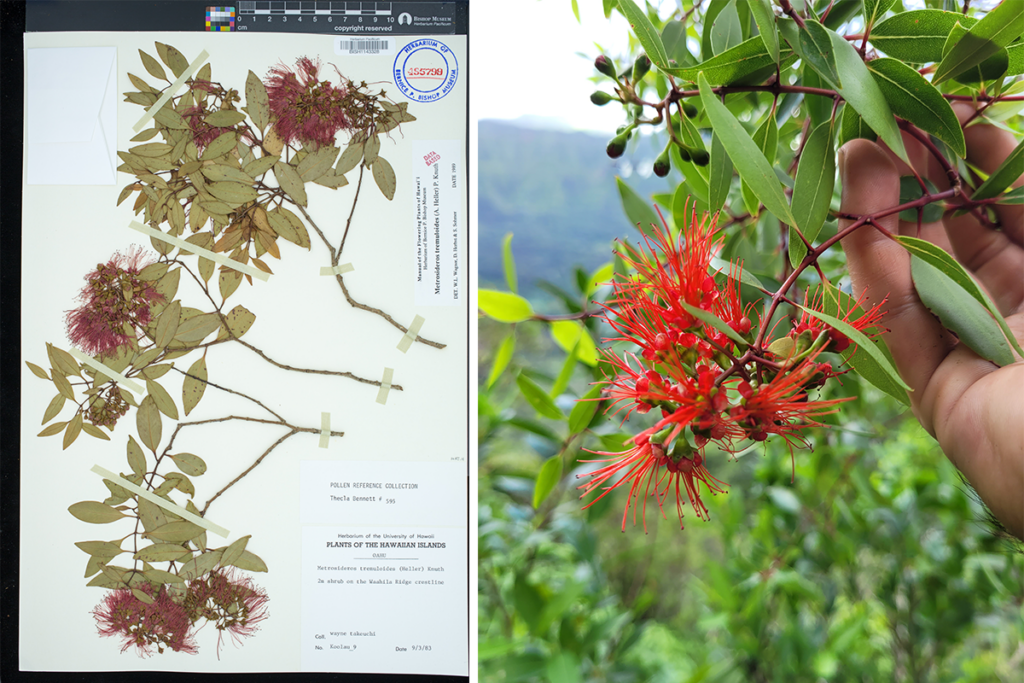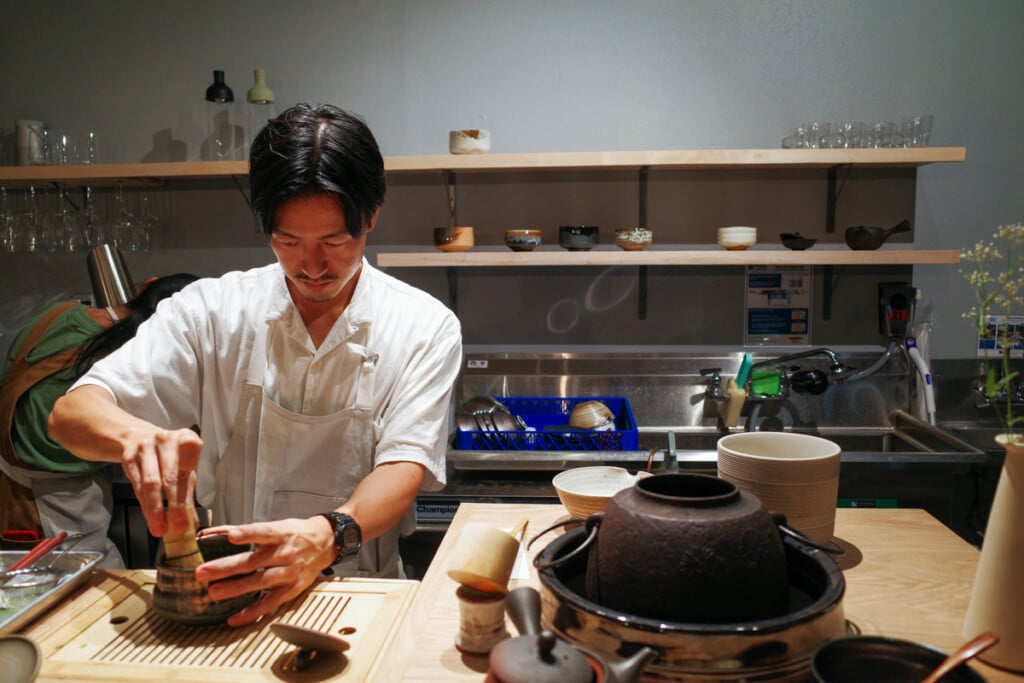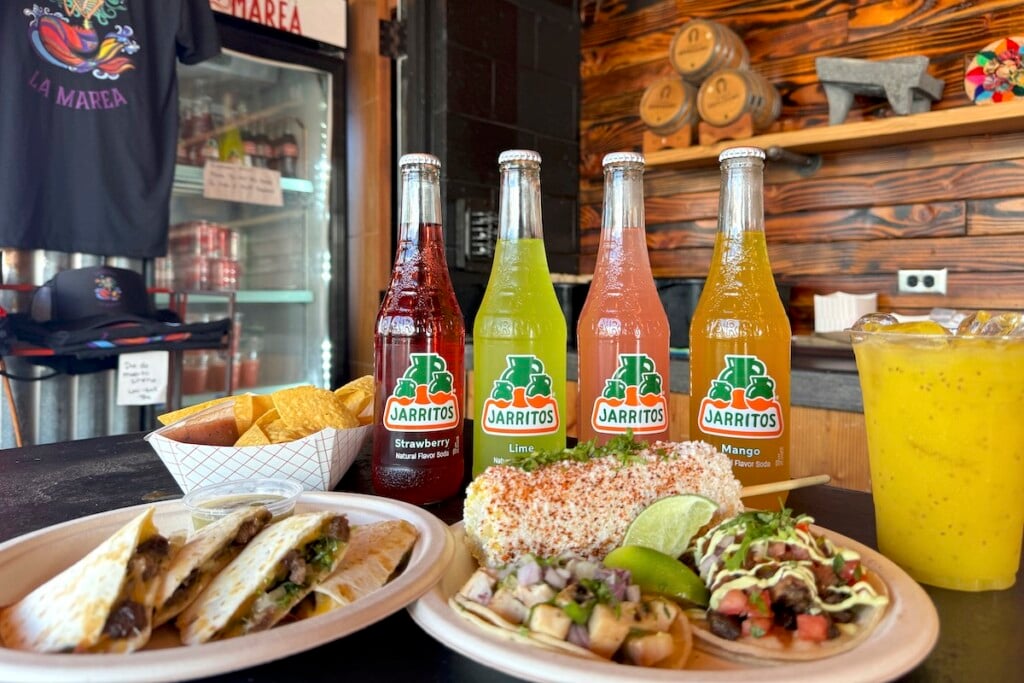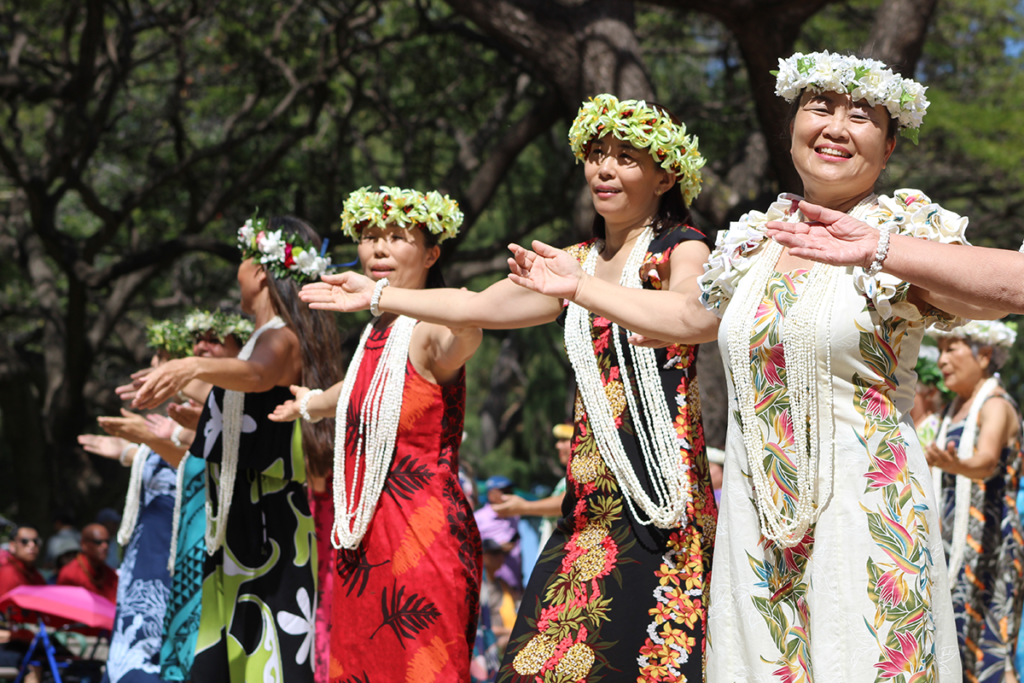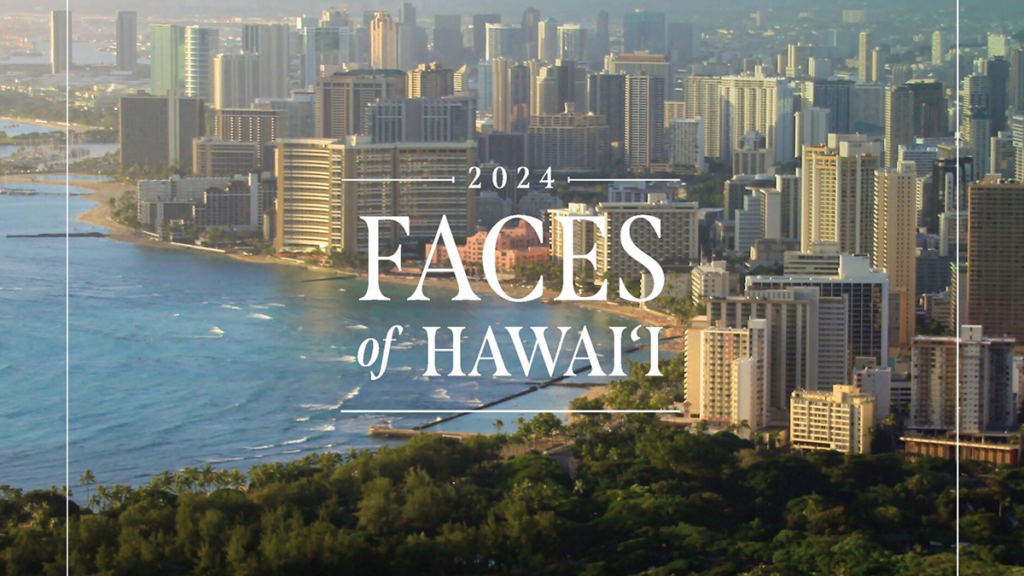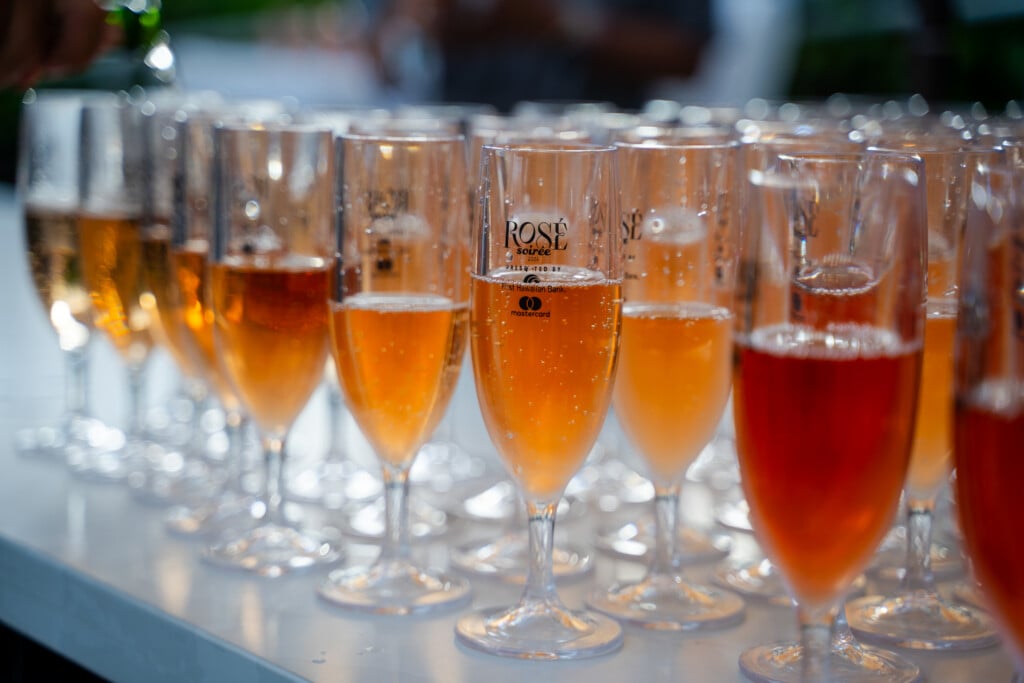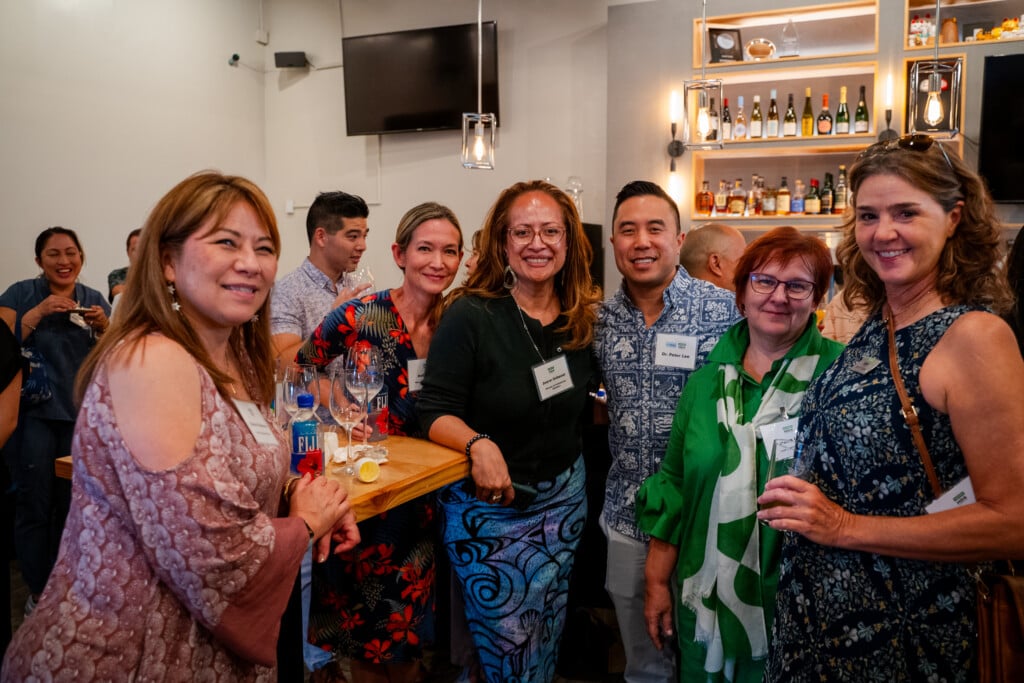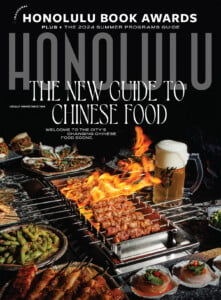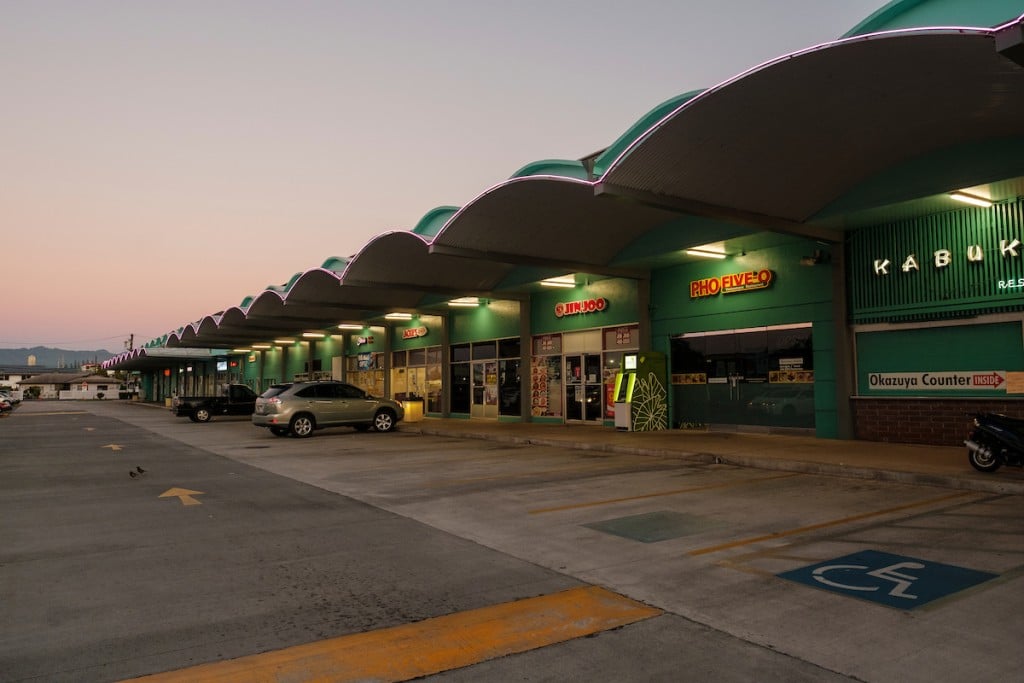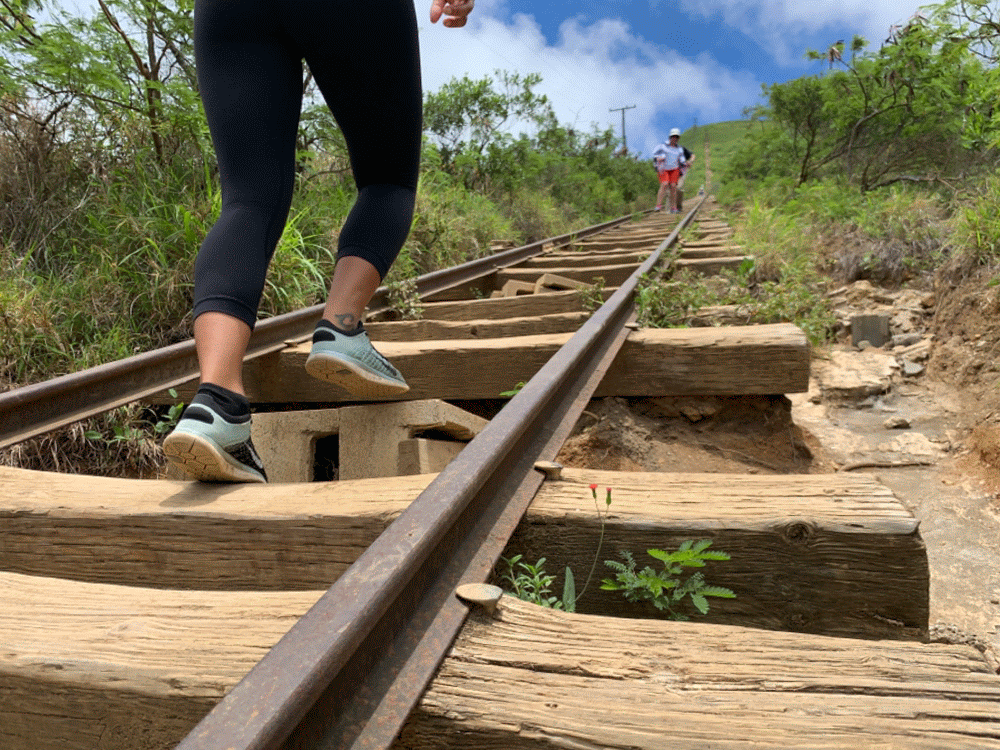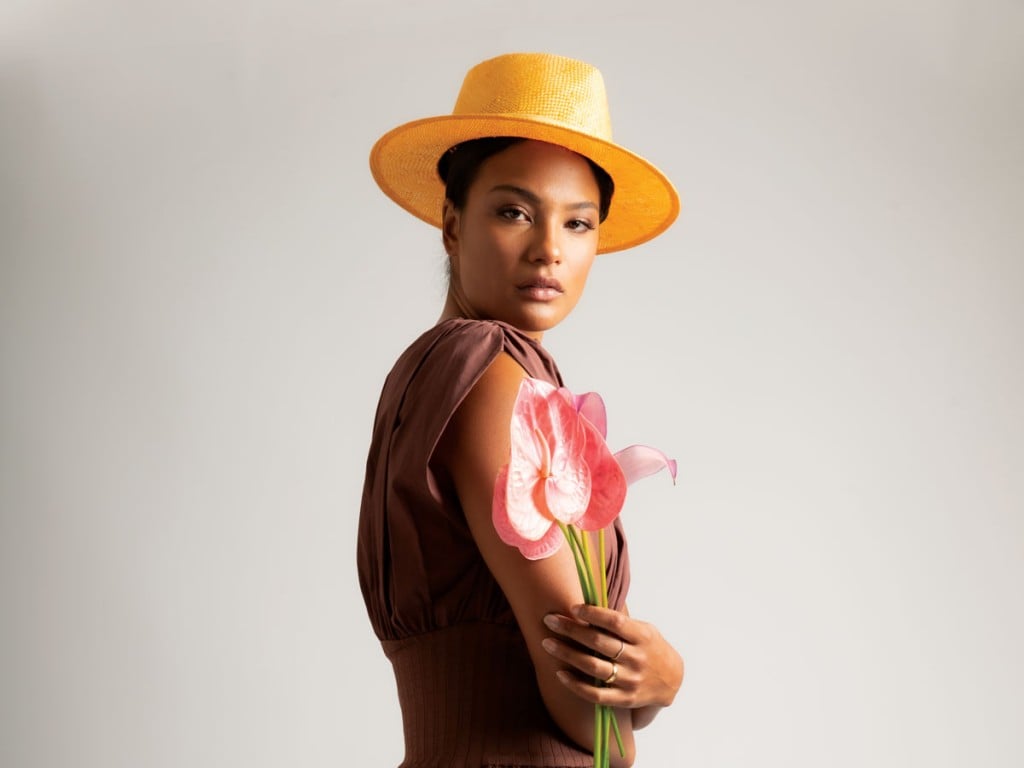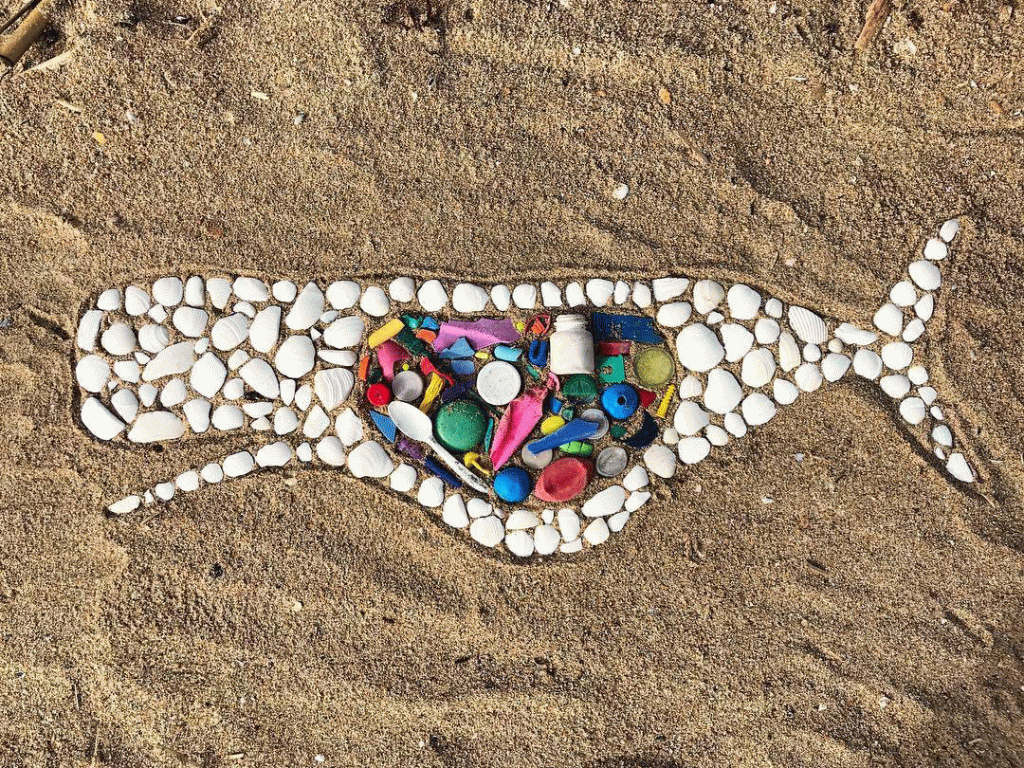3 International Market Place Restaurants That are Worth the Trip to Waikīkī
The newly renovated International Market Place sports a new luster with luxe retailers and exciting restaurants, while retaining some of its old charm.

b. Patisserie pastry chef Susannah Schoolman bakes kouign amann daily.
Photos: Steve Czerniak and Aaron Yoshino
Everyone’s got a story about the International Market Place. Some remember listening to Don Ho perform at the Duke Kahanamoku restaurant and club in the ’60s. Some remember the Gourmet Bazaar, where you could get European cheeses and bottled sweetmeats. Still others fondly recall the strange things you could buy there, from fake IDs to gold chains by the foot.
Today, high-end fashion has replaced cheesy T-shirt vendors, and all-star chefs have supplanted fortune tellers.
The International Market Place of the past is gone, despite last-ditch efforts to save the decaying, kitschy shopping bazaar that had long been an iconic—and, to some, beloved—focal point of Waikīkī.
Replacing the maze of open-air kiosks, steep gable roofs and a rundown food court is a dazzling new, three-story shopping and dining complex with meandering walkways and terraced levels anchored by the upscale Saks Fifth Avenue and the restaurant-laden Grand Lānai. The 345,000-square-foot, open-air marketplace boasts roughly 100 stores and restaurants, many of them unique to the center, and a 700-stall parking structure—yes, in Waikīkī!—that makes driving there a convenient option. The success of this complex, which is owned by the Queen Emma Land Co., benefits The Queen’s Medical Center.

“We want to encourage the locals to come back to Waikīkī,” says Robert Taubman, chairman, president and CEO of Taubman Centers, on a walking tour of the center in August. “With Saks and the Grand Lānai, we’re creating a destination that’s attractive to local customers.”
That has long been the goal of retailers and restaurateurs in Waikīkī in recent years: to lure the locals. Recent upgrades to the Royal Hawaiian Center and Waikīkī Beach Walk have worked to some degree, and new-to-Hawai‘i shops and restaurants including Urban Outfitters and H&M have been successful at enticing residents to venture along Kalākaua Avenue.
“Waikīkī has tremenously cleaned up and has been very local-friendly,” says Ivy Nagayama, managing partner of Sansei Seafood Restaurant & Sushi Bar and d.k Steak House, two restaurants that have been in Waikīkī for 12 years and that serve more local customers on the weekends now than tourists. “I think with the transformation of the International Market Place, locals will be curious.”
The Grand Lānai, which consumes the entire third floor of the complex, seems to be the bait that will work with locals, with nine new restaurants including the first Hawai‘i location for chef Michael Mina’s Stripsteak and the first O‘ahu location for chef Roy Yamaguchi’s Eating House 1849. And on the first floor is the flagship café for Kona Coffee Purveyors—a favorite of coffee aficionados—which serves fresh pastries, including the specialty kouign amann, from San Francisco’s b. Patisserie.
There. Three reasons to brave Kūhīo Avenue.
 |
This is how many people—locals and visitors—remember the International Market Place.Photo: Courtesy of International Marketplace |
Even the design of the Grand Lānai kept local folks in mind.
The early concept was to create a living-room feel, says Hilo native Rob Iopa, president of WCIT Architecture, who worked on the project. Instead, it was modified to a lānai, where local families and friends tend to gather. And putting it on the third floor—instead of the ground floor to attract foot traffic—makes these restaurants a destination.
“There are very few places where you can dine under the stars, under a banyan tree, in Waikīkī,” Iopa says. “This is very special.”
Eating House 1849
Suite 322, 924-1849
A lot has happened since chef Roy Yamaguchi opened his first restaurant in Waikīkī, on the corner of Ala Moana Boulevard and Kalākaua Avenue. (It has since closed.)
He has won the prestigious James Beard Award, written cookbooks, grown a collection of restaurants across the U.S., hosted a TV show, been part of an entire culinary movement and helped create a food and wine festival.
This year, Yamaguchi, 60, is opening four more restaurants, the latest of them his second Eating House 1849 at the International Market Place. (His first is located in Kōloa, Kaua‘i; this is his second restaurant in Waikīkī.)

Eating House 1849 pays homage to Hawai‘i’s culinary past and plantation roots, with dishes influenced by a variety of ethnic flavors and using local ingredients. You’ll find Portuguese bean soup with kale grown at Otsuji Farms in Hawai‘i Kai; pork adobo lumpia with green papaya and sambal tomatoes; plantation-style paella with Kaua‘i prawns, clams, chicken, tako and linguica.
This is Yamaguchi having fun.
“I took the values and flavors of my grandfather, who worked on the plantation [on Maui] and turned that into something modern,” Yamaguchi says. “I’m not doing anthing fancy, but I’m definitely making great food.”
Eating House 1849 is a departure from his signature Roy’s Restaurants, which show off Yamaguchi’s formal schooling, French training and world travels. The dishes are more refined, the flavors more intense and layered. At Eating House, he says, it’s more about tradition and familiar flavors done in a contemporary way.
 Just two weeks after opening, the restaurant on the Grand Lānai has a steady flow of customers, a mix of locals and visitors, enjoying the open-air seating and laid-back ambiance. The table next to us—friends curious about the new restaurant—ordered the 1849 spicy ramen bowl ($22) and the already-popular Hawai‘i Ranchers beef loco moco ($22). Ramen noodles drown in a rich sesame broth dotted with oil, with shoyu pork, shrimp dumplings and a soft local egg. The loco moco features Big Island beef sitting on a hefty patty of fried rice, a sunny-side-up local egg and a mushroom-veal gravy. Neither friend had any complaints.
Just two weeks after opening, the restaurant on the Grand Lānai has a steady flow of customers, a mix of locals and visitors, enjoying the open-air seating and laid-back ambiance. The table next to us—friends curious about the new restaurant—ordered the 1849 spicy ramen bowl ($22) and the already-popular Hawai‘i Ranchers beef loco moco ($22). Ramen noodles drown in a rich sesame broth dotted with oil, with shoyu pork, shrimp dumplings and a soft local egg. The loco moco features Big Island beef sitting on a hefty patty of fried rice, a sunny-side-up local egg and a mushroom-veal gravy. Neither friend had any complaints.
We wanted to try the gamut, starting with the Kona kampachi sashimi (market price), ultra-thin slices of raw kampachi topped with lomi tomatoes, diced sweet onions, ogo and a light citrus-soy vinaigrette. The ikura adds saltiness, the ogo a taste of the ocean. The pipi kaula and Hanalei poi appetizer ($18) is an elevated take on a simple combination you’d eat at a beach barbecue. The pipi kaula is cut from a marinated, aged sirloin that’s seared to a bright pink center. The slices are paired with a generous serving of sweet Hanalei poi, cherry tomatoes from Ho Farms, spicy watercress from Sumida Farm and slices of ali‘i mushrooms.
One dish that feels like all the best parts of a lū‘au is the shortrib ($34), two caramelized chunks of fork-tender beef sitting in a mixture of sweet potato gratin, local poi and chili-pepper water. With lomi tomatoes on top of the beef and lau lau greens on the bottom, the only thing missing is chicken long rice.

THE PIPI KAULA AND HANALEI POI AT EATING HOUSE 1849 COMES WITH HO FARMS TOMATOES AND ALI‘I MUSHROOMS.
An interesting entrée—and one that’s quickly become one of the restaurant’s most ordered—is the house-made corned beef reuben ($19), with gooey Gruyère and Swiss cheeses, mul kim chee (not too spicy) and a house Thousand Island dressing sandwiched between two crispy-grilled slices of bread. Imagine a grilled cheese sandwich stuffed with corned beef. It’s so rich and hearty, it’s actually hard to finish, though you’ll want to.
Skip Yamaguchi’s signature melting hot dark-chocolate soufflé here and get the Hōnaunau cinnamon-dusted malassadas ($9). Half a dozen small, square-shaped, deep-fried malassadas are coated in cinnamon-sugar and accompanied by a Kōloa Rum sauce. They’re crispy and doughy and not easy to share.
The Waikīkī menu is composed of tried-and-true dishes from the Kaua‘i restaurant, but Yamaguchi expects to add another dozen slowly over the next few months.
“We’re still evolving,” he says.
Stripsteak
Suite 330, 800-3094
O pening a restaurant in Hawai‘i has been renowned chef Michael Mina’s dream, ever since he participated in an anniversary dinner for chef Roy Yamaguchi 20 years ago.
pening a restaurant in Hawai‘i has been renowned chef Michael Mina’s dream, ever since he participated in an anniversary dinner for chef Roy Yamaguchi 20 years ago.
“I had never encountered the kind of hospitality I encountered here,” says the friendly, Egypt-born James Beard award-winning chef, who visits the Islands often with his family. “A couple of times, I got close to opening a restaurant, but it never happened. When this became a reality, it was really a dream come true.”
Mina opened Stripsteak Waikīkī in August, the brand’s first location in Hawai‘i. (It’s his 29th restaurant worldwide and run by executive chef Ben Jenkins, an 18-year company veteran.) The 8,600-square-foot Stripsteak is a chic, modern chophouse featuring an evolving seasonal menu of fresh seafood, local ingredients and, of course, premium meats including melt-in-your-mouth Japanese A5 striploin and a 16-ounce bone-in New York strip, all slow-poached in butter and finished on the grill.

A SAMPLING OF STRIPSTEAK’S RAW MENU.
 |
Kaua‘i shrimp and scallops in a spicy red curry sauce. |
This restaurant, though, is a slight departure from his others, with smaller plates, healthier options, a bounty of local ingredients and subtle Japanese influences. Unique to the Hawai‘i restaurant are Michael Mina’s Tuna Poke ($19), with cubed ‘ahi, pine nuts, garlic, Asian pear, red and green jalapeño and chiffonade mint dressed with a heat-infused sesame oil; Kaua‘i shrimp with a gin-cocktail sauce ($25); and a lemongrass-poached local fish with soba noodles and Ho Farms green beans, finished with a tamari dashi ($38).
“The food scene [in Hawai‘i] has just erupted here and it’s going to keep going,” says Mina, who admits to indulging in the occasional plate lunch. “There’s such an emphasis on product now … and there’s so much more to choose from now. We always knew the mangoes in season are dynamite. But now there’s Kona lobster, Kona abalone, hearts of palm. What’s being grown here and what’s available—it’s moving fast.”

A TRIFLE-ESQUE DESSERT WITH MERINGUE AND FRESH FRUITS.
Steakhouses, by definition, have always been about the meat. But, over the years, the menus at these beef-centric restaurants have evolved to include lighter fare, sharable plates, leaner cuts and healthier sides. Not just huge slabs of juicy steaks, mounds of buttery mashed potatoes or thick-cut fries. Consider what Stripsteak offers: chilled lobster tacos topped with a Maui Gold pineapple salsa ($21), a side of addictive creamed corn with a touch of jalapeño presented in a mini All-Clad pot ($12), and a unique salad of locally grown heirloom tomatoes and ricotta-stuffed burrata on a bed of crispy quinoa and white balsamic vinegar ($15) that was easily one of the standout dishes at a recent lunch there.
 |
The Black Tai is a twist on the Mai Tai, with black sesame orgeat. |
But Stripsteak still delivers on the carnivore classics. There’s a hand-cut steak tartare with a truffle-potato foam ($24); various cuts of Angus and wagyu steaks with a slew of sauces and infused butters ($44 to $150); a decadent mac-and-cheese side with black truffle ($15); potatoes baked, mashed or fried ($12 to $13); and a Snapchat-friendly dish called “Instant Bacon,” slices of crispy Kurobuta pork belly and tempura oysters smoked in the kitchen and covered with a dome that, when opened tableside, releases the fragrant hickory smoke ($20).
“This is more of a fun experience,” Mina says.
b. Patisserie
Level 1, 845-1700
While the Grand Lānai gets all the attention from foodies, the first floor of the International Market Place is worth a visit, if only for a single pastry: the kouign amann.
Pronounced kween ah-mon, this fairly obscure French pastry was perfected by pastry chef Belinda Leong of b. Patisserie in San Francisco. She’s partnered with Kona Coffee Purveyors, which has its flagship café here, to serve this dense, sweet version of a croissant, along with her other bakery specialties.
Leong, who opened her bakery in 2013, first learned about kouign amann at Fauchon in New York more than 10 years ago.

“This product was just really unique and I thought, I’m going to keep trying to make it,” says the James Beard-nominated pastry chef and San Francisco native.
Now, this unique, labor-intensive pastry—like its croissant cousin, made with laminate dough and lots of butter—has started popping up in boutique bakeries including Dominique Ansel Bakery in SoHo (best known for the famous Cronut). It became the signature pastry at b. Patisserie, which Leong owns with fellow pastry chef Michel Suas. On a typical Saturday, the quaint bakery can sell 1,200 kouign amann.
All of the pastries served at Kona Coffee Purveyors are made in-house, under the direction of Susannah Schoolman, a pastry chef from b. Patisserie who moved here to oversee production.
On opening day in Waikīkī, the café sold 300 kouign amann, well more than expected.
Now you can have freshly baked kouign amann—plain ($5.50), chocolate ($6) and black sesame ($6), which is only available twice a year in San Francisco—whenever you want.

This Kona coffee tart is one of b. Patisserie’s unique-to-Hawai‘i desserts.
Kona Coffee Purveyors is also selling b. Patisserie’s popular croissants, madeleines, banana bread, gluten-free almond cakes and giant chocolate chip cookies. The bakery has also created a few unique-to-Hawai‘i menu items including a passion-fruit/lemon tart ($7) and a Kona coffee tart ($7) that uses coffee brewed at the café.
But the kouign amann is the big draw.
“I knew once I started making them, everyone would love them,” Leong says.
The Living Soul of the Market Place

Three things didn’t change with this new version of the International Market Place: the name, one of the vintage signs and the giant Indian banyan tree.
It was planted in the mid-19th century by Harry Macfarlane, a New Zealand entrepreneur. William Lunalilo, Hawai‘i’s first elected king, owned the property and kept the tree as part of his summer home. He bequeathed the property to a friend, Queen Emma.
From the time the International Market Place opened in 1956, this tree has stretched its limbs and welcomed visitors from around the world. As the center evolved from a faux-Polynesian village to a meandering, open-air souvenir bazaar to its latest iteration, the tree has remained a fixture in the heart of Waikīkī.
Much of the credit goes to Steve Nimz, an arborist who has been caring for this tree since 1971.
“I know the ins and outs, its quirks, what’s going on and what it’s going through,” he says.
The banyan, valued at $8 million, is on the city’s list of exceptional trees. Meaning it’s protected and can’t be moved, pruned or cut down without the city’s permission.
Nimz was hired as a consultant almost five years ago, when designs were being drafted for this reimagined center. From the beginning, Taubman Centers, the primary developer, made sure this tree would be taken care of, starting with a tree protection plan that required every worker who set foot on the site go through an orientation about the tree and sign a paper saying they understood its importance. If anyone had to do any work near it, Nimz had to be called first.
“The whole thing started off on the right foot,” he says. “Without those marching orders, we never could have saved that tree.”
Oh, there were challenges. Pipes had to be fitted underneath its roots instead of cutting them, which would have been simpler. Moisture sensors were placed all over the tree so Nimz could monitor when it was stressed or needed water. Contractors had to rethink how they worked, moved equipment and cleaned up after.
Once, a manu-o-Kū (white fairy tern) built a nest on a branch that stretched over a walkway—and laid an egg. Since this was a protected bird, Nimz had to find a way to keep it—and the tree—safe. So he erected a tent underneath the bird to protect it from the construction happening beneath it and put up signs reminding workers about this inconvenient nesting site. This went on for three months.
“The workers really got into it,” Nimz says. “They were all watching this thing, making sure no one damaged it. They were really excited about the bird. And they were really conscious of the concerns with the tree. It was rewarding.”
Toward the end of construction, Nimz was concerned that the tree didn’t look happy. But just before the center’s opening, it suddenly dropped its dusty leaves and sprouted new, healthy ones.
“It couldn’t have looked any better,” Nimz says. “We helped guide the tree, but that tree really wanted to live. That tree is a fighter.”
What’s New
Here are six other restaurants opening in the Grand Lānai at the newly renovated International Market Place, including a local favorite:
Baku
This Japanese restaurant is billed as an East-meets-West concept, with a robata grill, fresh sushi and sashimi, ramen bowls, steamed buns and an extensive sake and wine program.
 Flour & Barley
Flour & Barley
This spin on a traditional pizzeria, helmed by executive chef Anthony Meidenbauer, will offer wood-fired pizzas, paninis, salads, handcrafted cocktails and beer.
Goma Tei
A local favorite, this fast-casual ramen shop will offer its popular tan tan ramen, rice dishes, curries, gyoza and tonktasu. This is the chain’s first location in Waikīkī.
Herringbone
This fish-meets-field chain, currently in California and Nevada, opens its first location in Hawai‘i with an emphasis on line-caught seafood and high-quality meats.
Kona Grill
This Arizona-based restaurant, which opened in September, sprawls over 7,300 square feet and offers sushi and other dishes featuring the restaurant’s scratch-made sauces and dressings.
Yauatcha
This dim sum teahouse specializes in modern dim sum and wok dishes. It will feature a wide range of teas and patisserie items including handmade petits gâteaux, macarons and chocolate.
TAKEAWAY: Don’t stress the parking. Spend at least $10 at any retailer—including restaurants—and get free validation for the first hour, $2 for the second, $2 for the third. After that, it’s $2 per 20 minutes. Valet is offered for $5 plus any applicable parking fees.
READ MORE STORIES BY CATHERINE TOTH FOX
